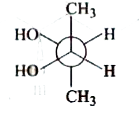Molecules whose mirror image is non-superimposable over them are known as chiral. Which of the following molecules is chiral in nature?
2-bromobutane
1-bromobutane
2-bromopropane
2-bromopropan-2-ol
The correct Answer is:A
To determine which of the given molecules is chiral, we need to analyze each option based on the definition of chirality. A molecule is considered chiral if it has a carbon atom that is bonded to four different substituents, making its mirror image non-superimposable over itself.
1. Understanding Chirality:
- A chiral molecule has a carbon atom with four different groups attached to it. This results in a non-superimposable mirror image.
2. Analyzing the Options:
- We will consider each option and check for the presence of a chiral carbon.
3. Option 1: 1,2-bromobutane:
- Structure: CH3-CHBr-CH2-CH3
- The carbon attached to bromine (C1) has the following substituents:
- CH3 (methyl group)
- CH2CH3 (ethyl group)
- H (hydrogen)
- Br (bromine)
- All four substituents are different.
- Conclusion: This molecule is chiral.
4. Option 2: 1-bromobutane:
- Structure: CH3-CH2-CH2-CHBr
- The carbon attached to bromine (C4) has:
- CH3 (methyl group)
- CH2CH2 (ethyl group)
- H (hydrogen)
- H (another hydrogen)
- Here, two substituents are the same (two hydrogens).
- Conclusion: This molecule is not chiral.
5. Option 3: 2-bromopropane:
- Structure: CH3-CHBr-CH3
- The carbon attached to bromine (C2) has:
- CH3 (methyl group)
- CH3 (another methyl group)
- H (hydrogen)
- Br (bromine)
- Again, two substituents are the same (two methyl groups).
- Conclusion: This molecule is not chiral.
6. Option 4: 2-bromopropan-2-ol:
- Structure: CH3-C(OH)(Br)-CH3
- The carbon attached to both bromine and hydroxyl (C2) has:
- CH3 (methyl group)
- CH3 (another methyl group)
- OH (hydroxyl group)
- Br (bromine)
- Here, two substituents are the same (two methyl groups).
- Conclusion: This molecule is not chiral.
7. Final Conclusion:
- The only chiral molecule among the options is 1,2-bromobutane (Option 1).
Summary:
The chiral molecule is 1,2-bromobutane.
---
- A chiral molecule has a carbon atom with four different groups attached to it. This results in a non-superimposable mirror image.
- We will consider each option and check for the presence of a chiral carbon.
- Structure: CH3-CHBr-CH2-CH3
- The carbon attached to bromine (C1) has the following substituents:
- CH3 (methyl group)
- CH2CH3 (ethyl group)
- H (hydrogen)
- Br (bromine)
- All four substituents are different.
- Conclusion: This molecule is chiral.
- Structure: CH3-CH2-CH2-CHBr
- The carbon attached to bromine (C4) has:
- CH3 (methyl group)
- CH2CH2 (ethyl group)
- H (hydrogen)
- H (another hydrogen)
- Here, two substituents are the same (two hydrogens).
- Conclusion: This molecule is not chiral.
- Structure: CH3-CHBr-CH3
- The carbon attached to bromine (C2) has:
- CH3 (methyl group)
- CH3 (another methyl group)
- H (hydrogen)
- Br (bromine)
- Again, two substituents are the same (two methyl groups).
- Conclusion: This molecule is not chiral.
- Structure: CH3-C(OH)(Br)-CH3
- The carbon attached to both bromine and hydroxyl (C2) has:
- CH3 (methyl group)
- CH3 (another methyl group)
- OH (hydroxyl group)
- Br (bromine)
- Here, two substituents are the same (two methyl groups).
- Conclusion: This molecule is not chiral.
- The only chiral molecule among the options is 1,2-bromobutane (Option 1).
The chiral molecule is 1,2-bromobutane.
Topper's Solved these Questions
- HALOALKANES AND HALOARENESBOOK - NCERT EXEMPLAR ENGLISHCHAPTER - HALOALKANES AND HALOARENESEXERCISE - MCQs (More than one option)
12 Videos
- HALOALKANES AND HALOARENESBOOK - NCERT EXEMPLAR ENGLISHCHAPTER - HALOALKANES AND HALOARENESEXERCISE - Short Answer Type Questions
35 Videos
- GENERAL PRINCIPLE AND PROCESSES OF ISOLATION OF ELEMENTS BOOK - NCERT EXEMPLAR ENGLISHCHAPTER - GENERAL PRINCIPLE AND PROCESSES OF ISOLATION OF ELEMENTS EXERCISE - Long Answer Type Questions
1 Videos
- P-BLOCK ELEMENTSBOOK - NCERT EXEMPLAR ENGLISHCHAPTER - P-BLOCK ELEMENTSEXERCISE - Long Answer Type Questions
3 Videos
Similar Questions
Knowledge Check
Which of the following molecules are chiral ?
 AI, II, III and IVBII, III and IVCII and IVDI and II
AI, II, III and IVBII, III and IVCII and IVDI and IIWhich of the following molecules are chiral ?
 AI and IIIBI and VCII and IIIDII, III, IV
AI and IIIBI and VCII and IIIDII, III, IVWhich of the following molecules are chiral?
A B
B C
C D
D

